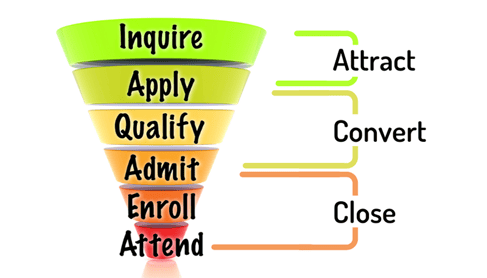The 4 letter word that's good for admissions
Lead. Yield. Call it what you will. Attracting candidates is important to every university. Most organizations are looking for ways to improve admissions results. Whether you’re trying to improve enrollment for the institution as a whole or for specific groups of students, it all starts with leads or yield.
At higher education institutions, there are two levers available to affect new student enrollment numbers.
- Increase or decrease the number of people who begin the admissions process
- Affect the percentage of those people who enroll and attend
Inbound marketing is the methodology applied to the second lever.
The funnel – describing the inbound process

You may have heard the term “funnel” before. In inbound marketing, you can think of a funnel as how people transition from the greater world into becoming a student. At the top of the funnel, you have the widest opening. This is where you are casting a wide net. As candidates engage with your institution and move toward enrolling; many will fall out of the process.
As mentioned above, higher education inbound marketing optimizes the percentage of candidates who enroll and attend. In most circumstances, this is where you can improve your results the fastest with the least cost and effort (since increasing the number people who enter the funnel involves additional advertising, buying lists, and in desperate situations, lowering admissions standards).
Attracting candidates
The early parts of the process are focused on getting a candidate interested enough to apply to the institution. Your advertising and recruiting efforts attract students to participate in the admissions process, and you nurture them to engage with you. This is the top of the funnel.
Converting candidates
In the middle part of the funnel, your institution is focused on converting those candidates. The candidate fills out an application, and you each qualify each other. Is your school right for them? Would the student be a good fit for your institution? Finally, do you and they have everything needed for them to enroll?
Closing: New students
In the final part of the funnel, you are closing the loop on the last steps of the process for them to be a student. The student needs to enroll, register for classes, and attend them. What steps are required to ensure that these steps are completed?
Conclusion
Now that we have introduced the general concepts of inbound marketing and aligned it to the higher education admissions process, we have a framework to delve into more detail as it relates to best practices for engaging with candidates, considerations for engaging at each stage, and how the inbound process can affect roles and responsibilities at your institution.
Our next article will will introduce techniques for effectively engaging with candidates within the inbound marketing process. Stay tuned.


